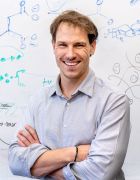
Prof. Dr. Job Boekhoven
Academic Career and Research Areas
The research group of Job Boekhoven (b. 1984) works at the interface between synthetic chemistry, biophysics, and biochemistry. Inspired by the chemistry of biology, we aim to synthesize molecular structures as complex, intricate, and beautiful as biology. Ultimately, we wonder if we can one day synthesize life from scratch. The motivation is to understand better what life is. How did it emerge at the origin of life? And if you were to look for life outside of Earth, what should you actually be looking for? Besides, our research also finds application in materials science.
Boekhoven holds an undergraduate degree in chemistry from the University of Groningen, where he majored in organic chemistry, and a PhD degree (2012) in chemistry from Delft University of Technology, both in the Netherlands. Before his appointment at TUM, he was a Rubicon postdoctoral fellow at Northwestern University in Chicago. In January 2016, Boekhoven was appointed Rudolf Mößbauer Professor at TUM. In 2022, he was promoted to Associate Professor at TUM.
Awards
- ERC Consolidator Grant (2024)
- Dozentenpreis by the Verband der Chemischen Industrie (2024)
- ERC Starting Grant (2019)
- Volkswagenstiftung “Life?” grant (2019)
- Max Planck Fellow in the Matter to Life school (2019)
Key Publications (all publications)
Bergmann, A. M.; Bauermann, J.; Bartolucci, G.; Donau, C.; Stasi, M.; Holtmannspötter, A.-L.; Jülicher, F.; Weber, C. A.; Boekhoven, J. Liquid Spherical Shells Are a Non-Equilibrium Steady State of Active Droplets. Nat Commun 2023, 14 (1), 6552.
AbstractStasi, M.; Monferrer, A.; Babl, L.; Wunnava, S.; Dirscherl, C. F.; Braun, D.; Schwille, P.; Dietz, H.; Boekhoven, J. Regulating DNA-Hybridization Using a Chemically Fueled Reaction Cycle. J. Am. Chem. Soc. 2022, 144 (48), 21939–21947.
AbstractDonau, C.; Späth, F.; Sosson, M.; Kriebisch, B. A. K.; Schnitter, F.; Tena-Solsona, M.; Kang, H.-S.; Salibi, E.; Sattler, M.; Mutschler, H.; Boekhoven, J. Active Coacervate Droplets as a Model for Membraneless Organelles and Protocells. Nat Commun 2020, 11 (1), 5167.
AbstractTena-Solsona M, Rieß B, Grötsch RK, Löhrer FC, Wanzke C, Käsdorf B, Bausch AR, Mueller-Buschbaum P, Lieleg O, Boekhoven J. Non-equilibrium dissipative supramolecular materials with a tunable lifetime. Nature Commun. 2017; 8: 15895.
AbstractBoekhoven J, Hendriksen W, Koper G, Eelkema R, van Esch, J. Transient assembly of active materials fueled by a chemical reaction. Science. 2015; 349(6252): 1075-1079.
AbstractIf you wish your profile to be changed or updated please contact Franz Langer.